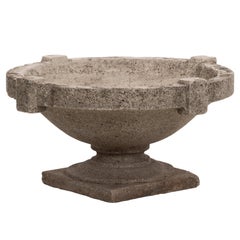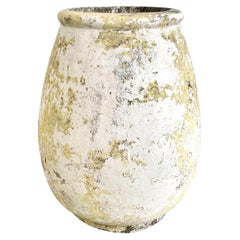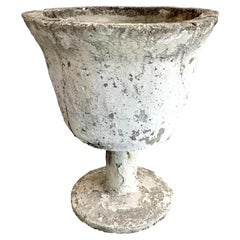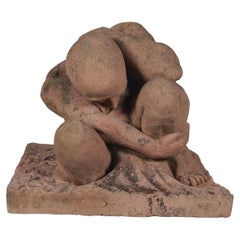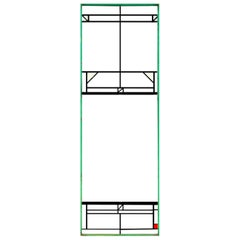Frank Lloyd Wright Building and Garden Elements
Without question the greatest architect the United States has ever produced, Frank Lloyd Wright and his philosophy of “organic architecture” — of buildings that exist in harmony with their natural surroundings — had a profound influence on the shape of modern life.
Wright gave us some of the most elegant and iconic buildings in America: residences such as Fallingwater, in rural Pennsylvania, the Robie House in Chicago, and Taliesin, Wright’s own home; and masterful institutional structures that include the Unity Temple in Oak Park, Illinois, the Johnson Wax headquarters in Racine, Wisconsin, and the Guggenheim Museum in New York. Whenever possible, Wright designed the furniture for his projects, to ensure an affinity between a building’s exterior and interior.
Wright’s wooden chairs and tables for his “Prairie Houses” of the early 1900s have sleek, attenuated forms, influenced by both the simplicity of traditional Japanese design and the work of Gustav Stickley and other designers of the Arts and Crafts movement.
For Taliesin and several residential projects, Wright designed severely geometric chairs that are marvels of reductivist design. He revisited many of these forms in the 1950s in furniture licensed to the North Carolina firm Henredon, adding a decorative frieze-like element to the edges of tables and stools. Owing to a cross-licensing agreement between Henredon and Heritage at the time, Wright's lines of the era are usually labeled Heritage-Henredon.
The works on 1stDibs also show how happily Wright embraced new forms and materials. His desks and chairs for Johnson Wax have a streamlined look and use tubular steel to the same effect as designer Warren McArthur, who collaborated with Wright in the interiors of the Arizona Biltmore Hotel. For the Price Tower (1956) in Oklahoma, Wright designed angular wooden desks as well as upholstered pedestal chairs made of chromed steel — audacious furniture for his tallest completed building project.
The beauty of Frank Lloyd Wright’s furniture designs is that while many of us wish we could live in one of his houses, his vintage sofas, storage cabinets and armchairs connect us directly to his architecture, and to the history he made.
Early 1900s American Organic Modern Antique Frank Lloyd Wright Building and Garden Elements
Cement
1960s Swiss Mid-Century Modern Vintage Frank Lloyd Wright Building and Garden Elements
Concrete
1960s Swiss Vintage Frank Lloyd Wright Building and Garden Elements
Concrete
20th Century European Greco Roman Frank Lloyd Wright Building and Garden Elements
Concrete
Mid-20th Century American Arts and Crafts Frank Lloyd Wright Building and Garden Elements
Cement
1960s Swiss Mid-Century Modern Vintage Frank Lloyd Wright Building and Garden Elements
Concrete
20th Century French French Provincial Frank Lloyd Wright Building and Garden Elements
Cast Stone
21st Century and Contemporary American Neoclassical Frank Lloyd Wright Building and Garden Elements
Concrete
20th Century Organic Modern Frank Lloyd Wright Building and Garden Elements
Stone, Concrete
20th Century Frank Lloyd Wright Building and Garden Elements
1960s Swiss Mid-Century Modern Vintage Frank Lloyd Wright Building and Garden Elements
Concrete
1960s Swiss Mid-Century Modern Vintage Frank Lloyd Wright Building and Garden Elements
Concrete
2010s American Modern Frank Lloyd Wright Building and Garden Elements
Iron
1960s American Arts and Crafts Vintage Frank Lloyd Wright Building and Garden Elements
Terracotta
Early 20th Century American Mission Frank Lloyd Wright Building and Garden Elements
Zinc
Mid-20th Century Italian Prairie School Frank Lloyd Wright Building and Garden Elements
Stainless Steel
Early 1900s American Prairie School Antique Frank Lloyd Wright Building and Garden Elements
Copper
Early 20th Century American Mission Frank Lloyd Wright Building and Garden Elements
Zinc
Mid-20th Century Italian Mission Frank Lloyd Wright Building and Garden Elements
Stainless Steel
Early 20th Century American Arts and Crafts Frank Lloyd Wright Building and Garden Elements
Clay
Mid-20th Century Italian Mission Frank Lloyd Wright Building and Garden Elements
Stainless Steel
Early 1900s American Prairie School Antique Frank Lloyd Wright Building and Garden Elements
Lead, Metal
Early 20th Century American Frank Lloyd Wright Building and Garden Elements
Lead
Early 20th Century American Prairie School Frank Lloyd Wright Building and Garden Elements
Lead
Early 20th Century American Art Deco Frank Lloyd Wright Building and Garden Elements
Copper
Frank Lloyd Wright building and garden elements for sale on 1stDibs.
- 1stDibs ExpertApril 5, 2022Frank Lloyd Wright broke away from Victorian-era architecture and created “Prairie-Style” out of the belief that there should be fewer, larger rooms that flowed easily. He was also a key player in the Art Deco movement. Shop a collection of expertly vetted Frank Lloyd Wright pieces from some of the world’s top sellers on 1stDibs.
- 1stDibs ExpertFebruary 1, 2024The style of Frank Lloyd Wright’s work is Prairie style. The architect pioneered the style, which draws inspiration from the natural beauty of the landscapes of the Midwest region of the U.S. Wright's design philosophy emphasized organic architecture, with buildings existing in harmony with their natural surroundings. His approach to architectural design had a profound influence on the shape of modern life, both while he was actively designing buildings and during the decades that followed. Shop a diverse assortment of Frank Lloyd Wright furniture on 1stDibs.
- 1stDibs ExpertMarch 22, 2022Yes, Frank Lloyd Wright designed furniture. He believed that the interior of a home should complement its exterior. As a result, he created unique pieces for many of the buildings he designed. Some of his most notable pieces include the Taliesin Group cabinet and the Allen table. Find a range of Frank Lloyd Wright furniture on 1stDibs.
- 1stDibs ExpertApril 5, 2022Yes, Frank Lloyd Wright made lamps. A stained-glass lamp he designed in the early 1900s was found at an antique shop in Chicago, abandoned during World War II. The lamp went on to break records at Christie’s auction, selling for over $700,000 in 1998. Shop a collection of expertly vetted Frank Lloyd Wright pieces from some of the world’s top sellers on 1stDibs.
- 1stDibs ExpertFebruary 27, 2024Frank Lloyd Wright used a variety of materials. For his homes and commercial buildings, the American architect favored natural materials and obtained them from local sources whenever possible. Some materials commonly featured in Wright's buildings include concrete, zinc, glass bricks, stone and wood. Wright’s wooden chairs and tables for his “Prairie Houses” of the early 1900s have sleek, attenuated forms, influenced by both the simplicity of traditional Japanese design and the work of Gustav Stickley and other designers of the Arts and Crafts movement. His desks and chairs for Johnson Wax have a streamlined look and feature tubular steel. Shop a variety of Frank Lloyd Wright furniture on 1stDibs.
- 1stDibs ExpertFebruary 27, 2024Frank Lloyd Wright's most famous house is arguably in Mill Run, a small community located in the Laurel Highlands region of southwestern Pennsylvania. Wright designed the home, called Fallingwater, in 1935 for the Kaufman family, who founded and owned a department store chain. Located around 70 miles southeast of Pittsburgh, the home is now open for daily tours. Just 7 miles away from Fallingwater is a second Frank Lloyd Wright home, Kentuck Knob. Designed in 1954, it was formerly the home of the Hagan family, who were friends with the Kaufmans. Explore a range of Frank Lloyd Wright furniture on 1stDibs.
- 1stDibs ExpertFebruary 27, 2024Frank Lloyd Wright designed more than 1,000 homes and other structures over the course of his life. However, only about 400 of those designs were ever built. Some of his most famous homes include Fallingwater, the Frederick C. Robie House, the Hollyhock House, the Darwin D. Martin House and Taliesin. Explore a diverse assortment of Frank Lloyd Wright furniture on 1stDibs.
- 1stDibs ExpertJune 6, 2024Around 430 Frank Lloyd Wright buildings are left. The American architect designed thousands of buildings throughout his career, but only 511 of his works were ever built. Some of these were lost to natural disasters, while others were demolished by their owners. On 1stDibs, explore an assortment of Frank Lloyd Wright furniture.
- 1stDibs ExpertOctober 7, 2024The main difference between Frank Lloyd Wright and Le Corbusier is the architects’ philosophy. Frank Lloyd Wright helped pioneer organic architecture—buildings that coexist harmoniously with their natural surroundings. As a result, he often preferred to use natural and even local materials in his buildings and furniture. Le Corbusier was more progress-minded and sought to impose rational order on the world's chaos through design. He focused on designs for living in modern urban settings. In his furniture, he tended to blend natural and human-made materials, such as tubular chrome and genuine leather. On 1stDibs, shop a variety of Frank Lloyd Wright and Le Corbusier furniture.
- 1stDibs ExpertApril 5, 2022Frank Lloyd Wright's architecture style was known as the Prairie Style; his principles led to a better life for all. From low-pitched roofs to overhanging eaves against closed-in Victorian era designs, prevalent in their confined spaces, among other things. Find vintage and modern Frank Lloyd Wright's pieces from top sellers on 1stDibs.
- 1stDibs ExpertApril 5, 2024There are four Frank Lloyd Wright houses in Pennsylvania. They include Fallingwater in Stewart Township, Kentuck Knob in Ohiopyle, Suntop Homes in Ardmore and the Don Duncan House in Acme. In addition, Wright designed the Francis Little House Library in Allentown and the Beth Sholom Synagogue in Elkins Park. On 1stDibs, explore a variety of Frank Lloyd Wright furniture.
- 1stDibs ExpertFebruary 27, 2024The style of furniture that Frank Lloyd Wright used varied. Wright's wooden chairs and tables for his “Prairie Houses” of the early 1900s have sleek, attenuated forms, influenced by both the simplicity of traditional Japanese design and the work of Gustav Stickley and other designers of the Arts and Crafts movement. For several residential projects, Wright designed severely geometric chairs that are marvels of reductivist design. For the Price Tower in Oklahoma, Wright designed angular wooden desks as well as upholstered pedestal chairs made of chromed steel that are more in line with the mid-century modern style. On 1stDibs, shop a range of Frank Lloyd Wright furniture.
- 1stDibs ExpertNovember 26, 2024The Robie House by Frank Lloyd Wright is called Prairie-style architecture because of its characteristics. Wright pioneered Prairie-style architecture by designing homes in the Midwest using inspiration from the prairie landscapes found in the region. The earthy colors and organic textures of the Robie House’s brick, stucco and wood materials bring to mind the color of the prairies, and its low-pitched roof, strong horizontal lines and elongated rectangular windows reflect the flatness of the terrain. Inside, the home features wide-open spaces that provide extended sight lines similar to how you can see far into the distance when gazing out across a flat prairie. Shop a collection of Frank Lloyd Wright furniture on 1stDibs.
